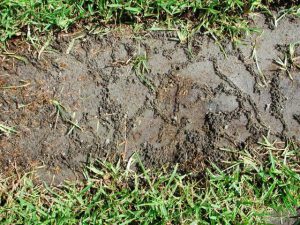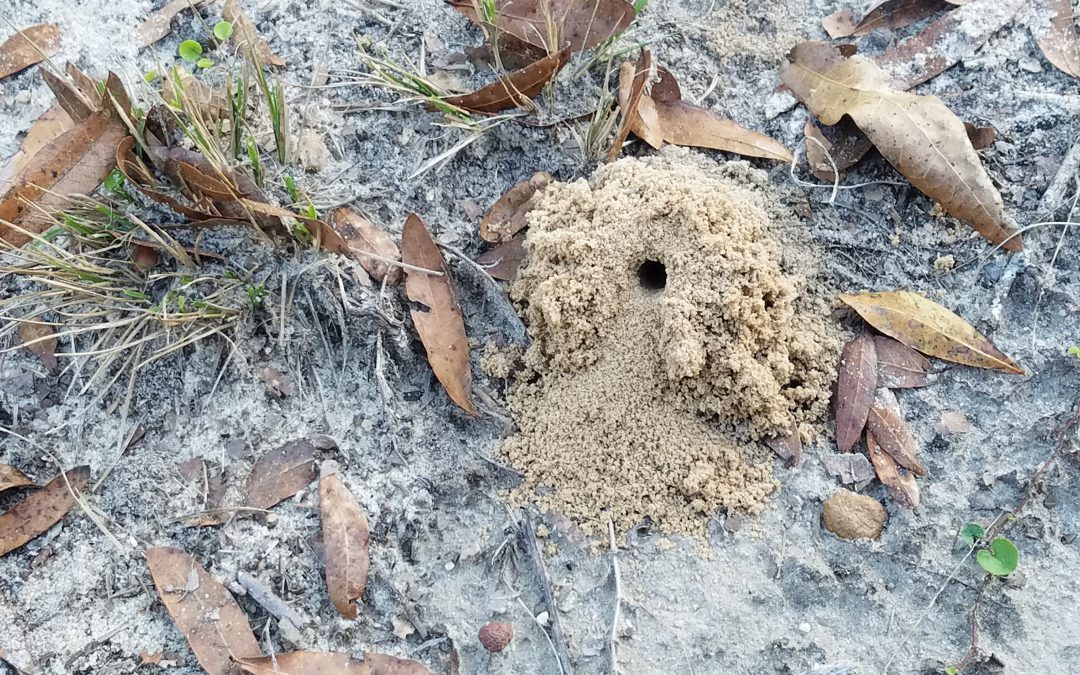
by Evan Anderson | May 20, 2021
Lawns and landscapes are greening up this time of year, and it’s not just plants showing signs of activity. All sorts of creatures are out there living their lives, and some of them are doing some digging.
From little piles of dirt to big mounds and long tunnels, it can be frustrating to figure out what is disrupting your carefully tended lawn or ornamental bed. Luckily, there are differences between the possible culprits. Here are some of the possibilities (see the associated links for more information and control methods):
-
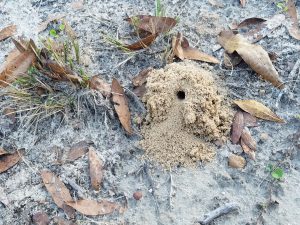
A miner bee hole. Photo: Evan Anderson
Miner Bees (and other ground nesting bees and insects) – Miner bees are harmless, solitary bees that tunnel into the soil. Not to be mistaken for yellowjackets, each bee digs her own small nest to lay her eggs in. Multiple such bees may be attracted to the same location, but they do not form hives and aren’t aggressive. Small mounds of soil may form around the entrances to their nests, but these will vanish after a rain.
- Moles – Small mammals (not rodents) that produce raised tunnels along the surface of the ground. They forage for insects among the roots of plants, and while their presence does have some benefits, many homeowners dislike their aesthetic contributions to the landscape. If you can overlook their tunnels, they do help aerate soil and eat pests like mole crickets, grubs, ant larvae, caterpillars, and slugs.
- Pocket Gophers – Sometimes called “sandymounders” or “salamanders” by old-timers, these are small rodents that dig tunnels beneath the ground. Active especially in cooler months, they make a series of mounds of soil in a line along their tunnel as they excavate. They feed on roots, bulbs, and tubers, though their sand-mounding is often more a problem than their feeding.
-
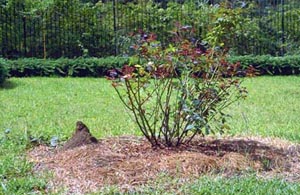
A fire ant mound in the landscape. Photo: B. Drees
Fire Ants – A single ant isn’t particularly threatening, but fire ants have found that thousands of rage-filled friends make a good deterrent. They build large mounds of soil to help regulate temperature and moisture in their nests, which can be quite unsightly in the landscape. Disturbing these mounds will unleash hordes of stinging ants, so beware; while they don’t necessarily do any harm to plants, they aren’t terribly friendly neighbors.
- Squirrels -These tree-dwelling rodents may nest up in the boughs, but often come down to the ground to look for food. In doing so, they may dig small holes as they forage for nuts, seeds, and fungi. The holes they dig are typically shallow and usually not too much of a problem.
- Armadillos – Nocturnal and heavily armored, the armadillo forages for insects in the ground. While it may sound beneficial to have an animal removing all the pest insects around, they aren’t careful about the damage they do while they feed. A hungry armadillo can dig numerous 3-5 inch wide, 1-3 inch deep holes in a lawn overnight, and may also burrow under structures, driveways, and patios.
- Yellowjackets – Yellowjackets are a bit of an honorable mention for this list, due to the fact that their digging often goes unseen. These ground-dwelling hornets leave no mounds or raised tunnels to identify their nests by. Instead, a small hole is often the only indication they are present, until a person or pet disturbs them. Then…surprise! It’s time for stinging, screaming, and crying.
For animal pests, the Florida Fish and Wildlife Conservation Commission maintains a list of nuisance wildlife trappers at https://public.myfwc.com/HGM/NWT/NWTSearch.aspx. For insects, you may need to contact a local pest control specialist or company. For help in identifying a problem, contact your local Extension office.
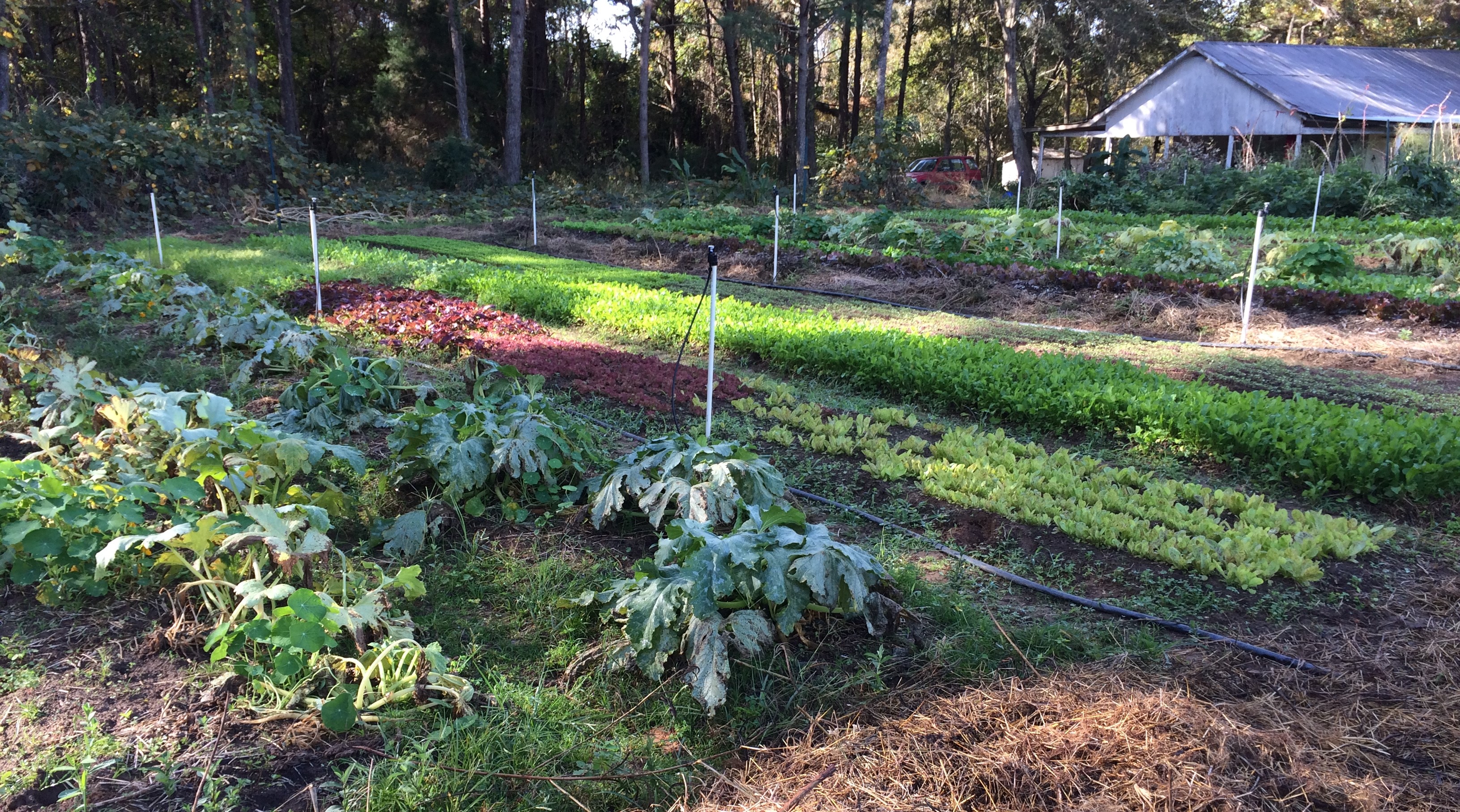
by Molly Jameson | Nov 13, 2017

Take lessons from a farmer to control fire ants in your garden. Photo by Molly Jameson.
As I near the three-year mark of being an Extension Agent, I think about how fortunate I am to have a career that not only encourages me to meet all our local farmers, but also to learn from them and share their knowledge with the community.
A few months ago, I visited Blake Canter of Owen River Farm. Blake gave me the grand tour of his small mixed vegetable plot, which is in far east Tallahassee.
One thing that I remember most about my visit with Blake was what has worked for him in controlling the notorious red imported fire ant (Solenopsis invicta). I have heard of many different ways to control these non-native invaders, each with its drawbacks, and, it seems, anecdotally limited success.
For instance, spinosad, a nervous system toxin, has been known to be effective on fire ant populations and is considered safe to use in vegetable gardens. But in practice, I have heard mixed reviews. In my home garden, I either douse the mounds with boiling water (be careful!) or leave my garden hose in the hot sun and scorch them while the water is still hot. But often, I signal defeat, letting them take captive of two corners of my raised beds.
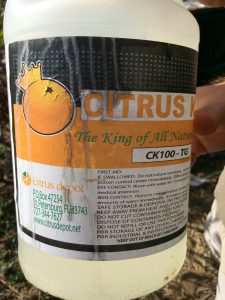
Blake at Owen River Farm makes his fire ant control mixture by combining commercial grade d-Limonene and a hefty squirt of eco-friendly dish soap into five gallons of water. Photo by Molly Jameson.
Blake’s technique on Owen River Farm is using commercial grade d-Limonene, which is a distilled orange oil nerve toxin. Blake mixes one-third cup of d-Limonene with a hefty squirt of eco-friendly dish soap in a five-gallon bucket of water. He then uses this mixture as a drench for fire ant mounds – which he figures is about as effective as boiling water – but much safer and easier to handle (be sure to follow the label carefully when using any product).
Blake goes out early in the morning (when fire ants move slower and queens are usually higher in their nests) and pours the mixture onto the mounds in a spiral formation, from outside in, to minimize escape. He tries to collapse the mound as much as possible, while pouring slowly so it penetrates deeply, with minimal runoff.
Depending on colony size, Blake uses about half the bucket, or more, on just one mound. He warns that he has lost a cucumber plant that was about a foot away to this method, but he knows the ants will often do even more damage, if not sting and bite (they do both!) him hundreds of times, as he works in his vegetable beds.
Blake likes this method because, “I can specifically target the fire ants, and after doing its job, the all-natural orange oil quickly becomes inert. When I used organic ant bait I found that the native ants took up the poison, often times faster than the fire ants. This was particularly bad because native ants are the number one competition for fire ants.”
Blake also points out, “Make sure anyone you recommend this to can identify the difference between fire ant mounds with no center opening to the mound, and native ant mounds, where there is usually an entrance hole in the center of the mound.”
The hardest part, Blake says, is finding the queens. For instance, he says ants often make auxiliary mounds at the base of okra plants, but this is not where the queen resides. The queen will often be in a central mound many yards away from where her workers are foraging. And, unfortunately, these worker ants love easily habitable soft soil, just like in our raised bed vegetable gardens.
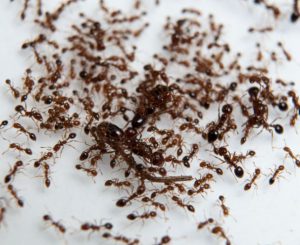
Fire ants in a petri dish. Photo by UF/IFAS.
Despite these challenges, last fall Blake drenched colonies whenever he found a mound around his farm (sometimes daily), and after a few weeks he noticed a drastic reduction in fire ant populations. And happily, an increased population of harmless (and even helpful!) native black ants. His brassica (think kale, collards, broccoli, cabbages) transplants were no longer getting girdled by vicious fire ants and he was no longer ending up with dozens of ant bites every time he worked in his beds!
Blake does warn that you must stay vigilant, especially in the summer and fall and after rain events, when the ants become busy building new colonies.
Lastly, Blake also uses his orange oil mixture as a spray for contact killing ants and other garden pests. However, just as with all horticultural oils and soaps (often made from plant oils, animal fats, or petroleum), care must be taken not to burn the foliage of your crops. Blake will sometimes dilute his mixture for this purpose. But just remember, to really stop an ant infestation, you must take down the queen!
For more information on least-toxic garden pest control strategies, read the UF/IFAS EDIS publication “Natural Products for Managing Landscape and Garden Pests in Florida” available at: https://edis.ifas.ufl.edu/in197.
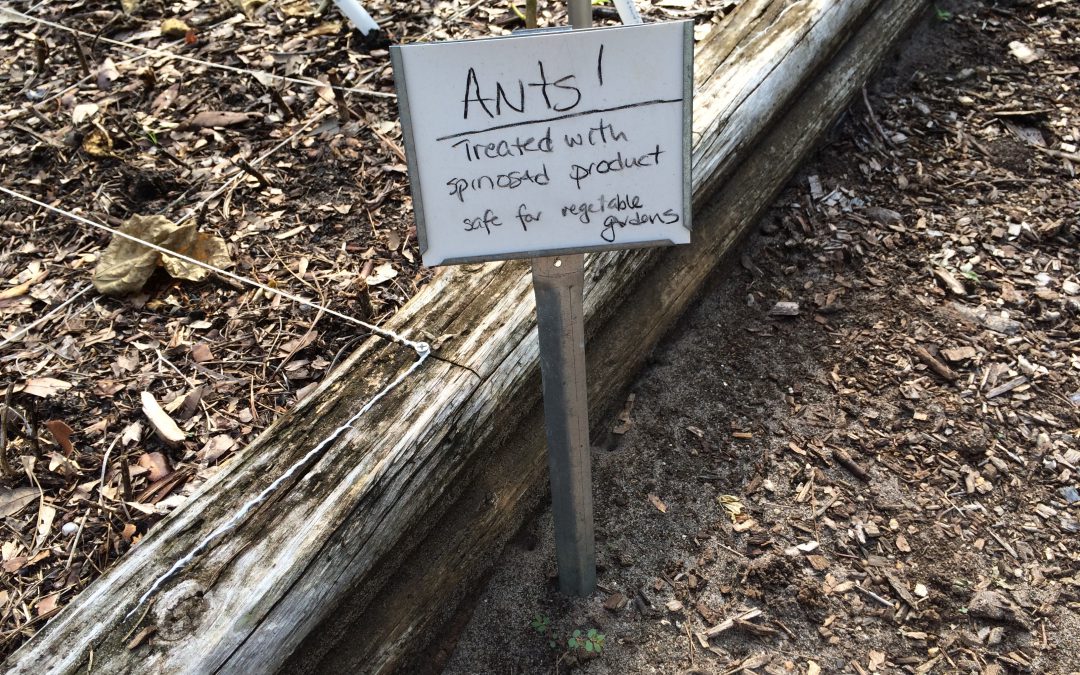
by Molly Jameson | Aug 12, 2016
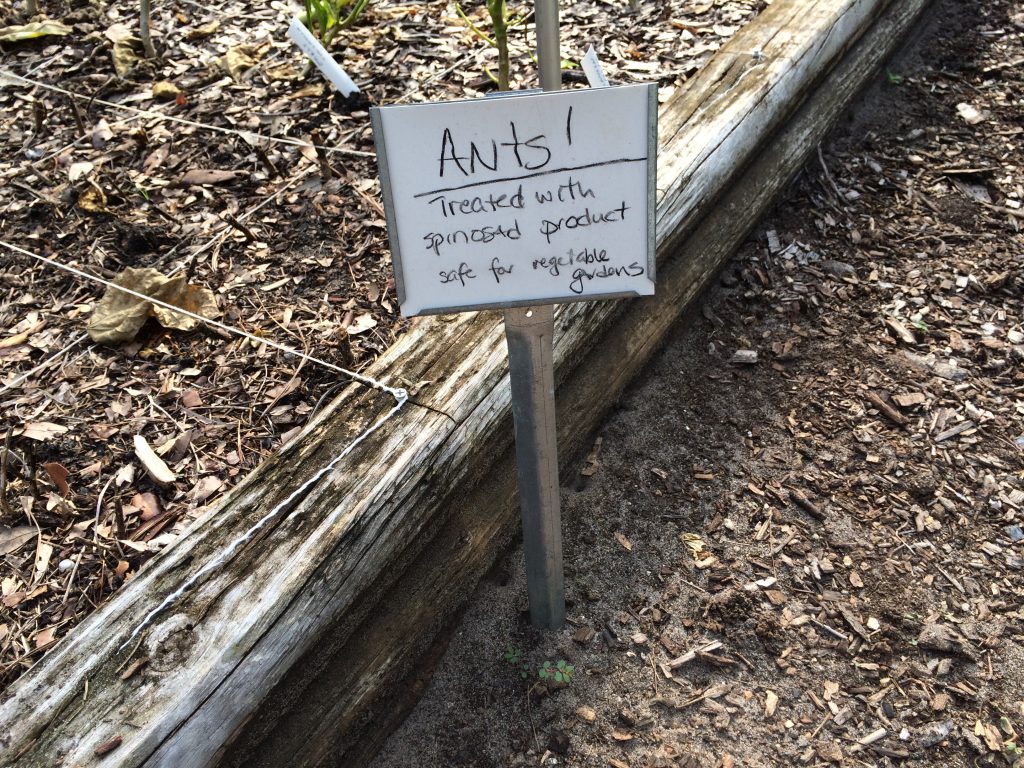
Ants can be treated with spinosad in vegetable gardens. Photo by Molly Jameson.
There’s nothing worse than sinking your fingers into your garden soil to dig up a potato, plant a seedling, or pull up a radish, and be met with a sharp, painful sting, and little red critters rocketing up your arms. If you are a gardener in the panhandle, my bet is that you know exactly to what I refer: fire ants!
Fire ants are certainly not native to our area. These guys are an invasive species from South America that are very resilient, and many are territorial, with the potential to drive out any native ant populations. Fire ants arrived in the 1930s, and can now be found throughout most of the southeastern United States.
So when you end up with fire ant mounds engulfing your carrot patch, what can be done? Since fire ants in your garden mean fire ants in your food, the least toxic control methods are of high importance and conventional broadcast bait treatments and mound treatments should be avoided. Even in your lawn, be careful when using strong insecticidal bait treatments, as these can harm the native ant populations that help control the spread of fire ants. This can then lead to a strong resurgence of fire ant populations that can outcompete the native ants.
Although completely controlling fire ants in an area is not possible, there are sustainable management techniques that can help. Some fire ant colonies have a single queen while others have multiple queens. Either way, in order to eliminate a fire ant colony, all queens in the colony must be killed. Fire ants are omnivorous, in that they eat plants, insects, sugars, and oils. The catch is that they are only able to ingest liquids, so solid food must be brought into the colony, where larvae regurgitate digestive enzymes onto the food, breaking it down into liquids. Therefore, any method of control by ingestion will need to be in liquid form, or the ants must be able to bring the material into the colony, without first being exterminated.
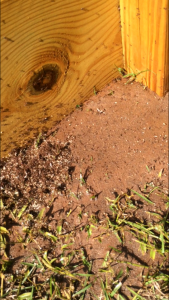
Fire ants can become a problem around and in raised vegetable gardens. Photo by Molly Jameson.
There are some commercially available products that contain boric acid or diatomaceous earth. These products may reduce populations, but eliminating whole colonies with these products can be a challenge.
The use of a nervous system toxin called spinosad is effective on fire ant populations and is considered safe to use in vegetable gardens. This toxin comes from a bacterial fermentation process, and is therefore considered organic. But be aware, even though there are organic products with ingredients derived from botanical sources such as rotenone and nicotine sulfate, they should not be used in vegetable gardens. When using chemical methods of control, always follow the directions on the label carefully.
One physical method of control is the use of hot water. Three gallons of scalding water, which is between 190 to 212ºF, has been used on colonies with a success rate of 20 to 60 percent, when applied in several treatments. You will want to slowly pour the water on the colony, being extra careful not to get burned, and avoid injuring any surrounding plants. If you are like I am, and you often leave your garden hose in the hot sun, you can spray the ant colonies with the hot water, as you wait for the water to cool off enough to water the garden. Hot water control takes persistence, but you can eventually drive the ants out.
Another method of physical control is excavation. This requires digging up the mound, putting it in a bucket, and taking it to another location. Apply talcum or baby powder to your shovel handle and bucket to help prevent the ants from escaping and crawling up to sting you.
One reason fire ants are so rampant in the United States is that they have little competition or natural enemies. Scientists have released multiple species of phorid flies, natural parasites of fire ants in South America, and a few species have become established. Scientists at UF/IFAS are currently researching additional fire ant biological control methods, such as the use of a fungi, which has shown promise.
Remember, not all ants in the garden are bad guys! Many species act as roto-tillers, aerating and redistributing nutrients in the soil. They also play a role as decomposers as they assist in turning dead insects into soil nutrients. Ants can disturb garden pests by attacking them or interrupting their feeding, mating, and egg laying processes. Additionally, ants are a food source for wildlife, such as other insects, frogs, lizards, birds, spiders, and even some mammals.
by Beth Bolles | May 5, 2016
Believe it or not, there is a beneficial ant that is found in many landscapes. If you see an interesting mound shaped like a small volcano, you likely have the pyramid ants. These ants form small nests in sandy soils and the mound will have a small opening in the very center.
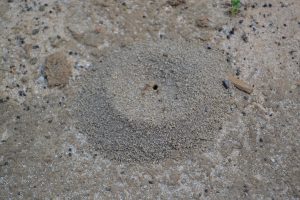
Pyramid ant mound, about 5 inches across. Photo by Beth Bolles
Pyramid ants are not aggressive and do not sting. They are fast moving over the ground building the mound and searching for food. Ants will collect honeydew from other insects and the beneficial part is that ants hunt live insects including winged fire ants. By allowing the pyramid ants to remain in parts of your landscape, you may reduce the numbers of fire ants that can establish in that area.
When you see the distinctive pyramid ant mounds, remember the beneficial role they play in keeping pest species in check. Keep any baits away from these areas to protect the pyramid ants.
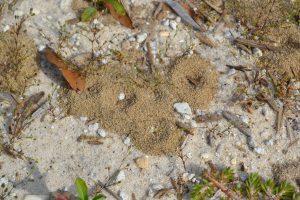
A group of small mounds. Photo by Beth Bolles



